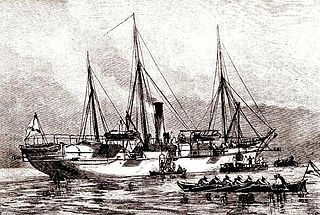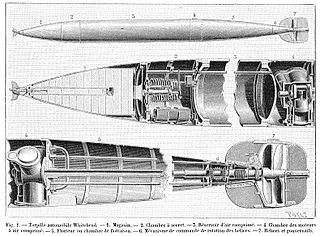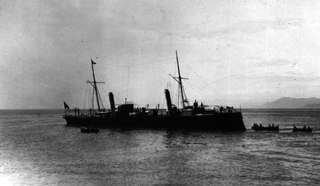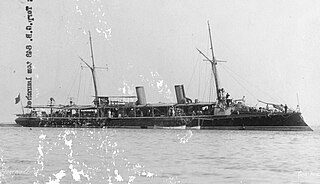
A modern torpedo is an underwater ranged weapon launched above or below the water surface, self-propelled towards a target, and with an explosive warhead designed to detonate either on contact with or in proximity to the target. Historically, such a device was called an automotive, automobile, locomotive, or fish torpedo; colloquially a fish. The term torpedo originally applied to a variety of devices, most of which would today be called mines. From about 1900, torpedo has been used strictly to designate a self-propelled underwater explosive device.

A torpedo boat is a relatively small and fast naval ship designed to carry torpedoes into battle. The first designs were steam-powered craft dedicated to ramming enemy ships with explosive spar torpedoes. Later evolutions launched variants of self-propelled Whitehead torpedoes.

A naval ship is a military ship used by a navy. Naval ships are differentiated from civilian ships by construction and purpose. Generally, naval ships are damage resilient and armed with weapon systems, though armament on troop transports is light or non-existent.

An ironclad is a steam-propelled warship protected by iron or steel armor plates, constructed from 1859 to the early 1890s. The ironclad was developed as a result of the vulnerability of wooden warships to explosive or incendiary shells. The first ironclad battleship, Gloire, was launched by the French Navy in November 1859 - narrowly pre-empting the British Royal Navy.

Robert Whitehead was an English engineer who was most famous for developing the first effective self-propelled naval torpedo.

Stepan Osipovich Makarov was a Russian vice-admiral, commander in the Imperial Russian Navy, oceanographer, member of the Russian Academy of Sciences, and author of several books. He was a pioneer of insubmersibility theory, and developer of a Cyrillic-based semaphore alphabet. A proponent of icebreaker use, he supervised the first ever polar icebreaker construction. Makarov also designed several ships.

Veliky Knyaz Konstantin was the name of a torpedo boat tender of the Russian Navy named after the Grand Duke (Veliky Knyaz) Konstantin of Russia, and which served in the Russo-Turkish War of 1877-78. Stepan Osipovich Makarov, a famous Russian Navy commander, was the captain of the ship.
Velikiy Knyaz Konstantin or Grand Duke Constantine may refer to:

SMS Deutschland was the second and final ship of the Kaiser-class ironclads; SMS Kaiser was her sister ship. Named for Germany, the ship was laid down in the Samuda Brothers shipyard in London in 1872. The ship was launched in September 1874 and commissioned into the German fleet in July 1875. Deutschland mounted a main battery of eight 26 cm (10.2 in) guns in a central battery amidships. She was the last capital ship built for the German Navy by a foreign ship-builder; all subsequent ships were built in Germany.

The Foudre was a French seaplane carrier, the first in history. Her development followed the invention of the seaplane in 1910 with the French Le Canard.

The Whitehead torpedo was the first self-propelled or "locomotive" torpedo ever developed. It was perfected in 1866 by Robert Whitehead from a rough design conceived by Giovanni Luppis of the Austro-Hungarian Navy in Fiume. It was driven by a three-cylinder compressed-air engine invented, designed, and made by Peter Brotherhood. Many naval services procured the Whitehead torpedo during the 1870s, including the US Navy. This early torpedo proved itself in combat during the Russo-Turkish War when, on 16 January 1878, the Ottoman ship Intibah was sunk by Russian torpedo boats carrying Whiteheads, though this story has been disputed in one book.

Mahmudiye was a ship of the line of the Ottoman Navy. It was a three-masted three-decked 128-gunned sailing ship, which could perhaps be considered to be one of the few completed heavy first-rate battleships in the world. Mahmudiye, with a roaring lion as the ship's figurehead, was intended to serve to reconstitute the morale of the nation after the loss of the fleet at the Battle of Navarino in 1827. The flagship was for many years the largest warship in the world.

SMS Blitz was an aviso of the German Kaiserliche Marine built in the early 1880s. She was the lead ship of her class, which included one other vessel, SMS Pfeil. Her primary offensive armament consisted of a bow-mounted torpedo tube, and she was armed with a battery of light guns to defend herself against torpedo boats, a sign of the growing importance of torpedoes as effective weapons in the period. The Blitz class featured a number of innovations in German warship design: they were the first steel hulled warships and the first cruiser-type ships to discard traditional sailing rigs.

Minerva was a torpedo cruiser of the Partenope class built for the Italian Regia Marina in the 1880s. The second of eight ships, Minerva was built by Gio. Ansaldo & C.; her keel was laid down in February 1889, she was launched in February 1892, and she was commissioned in August that year. Her main armament were her five torpedo tubes, which were supported by a battery of ten small-caliber guns. Minerva spent most of her career in the main Italian fleet, where she was primarily occupied with training exercises. She was converted into a minelayer in 1909–10. She did not see significant action during the Italo-Turkish War in 1911 or World War I in 1915–18, though she was used to lay defensive minefields during the latter conflict. The ship was sold for scrap in 1921.

Tripoli was the first modern torpedo cruiser built for the Italian Regia Marina. She was built by the Regio Cantiere di Castellammare di Stabia shipyard in 1885–86. The only vessel of her class, she provided the basis for the Goito and Partenope classes that followed. She was armed with five 14-inch (356 mm) torpedo tubes and a battery of light guns, and was capable of a top speed of 17.5 knots. Tripoli spent her career in the main Italian fleet, where she was occupied primarily with peacetime training exercises. She was modernized several times throughout her career, and in 1910, was converted into a minelayer, a role she served in for another thirteen years, including during World War I. She was the longest serving torpedo cruiser in the Italian fleet, with over 36 years in service by the time she was discarded in March 1923.

The Feth-i Bülend class was a class of two ironclad warships built for the Ottoman Navy in the 1860s and 1870s. The lead ship, Feth-i Bülend, was built in Britain, and served as the basis for the second, Mukaddeme-i Hayir, which was built in the Ottoman Imperial Arsenal. The design for the ships was based on the earlier Avnillah class, which were also built in Britain. Central battery ships, Feth-i Bülend and Mukaddeme-i Hayir were armed with a battery of four 222 mm (8.7 in) Armstrong guns in a casemate.


















